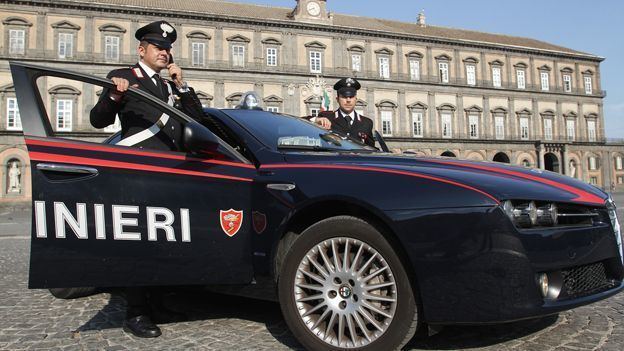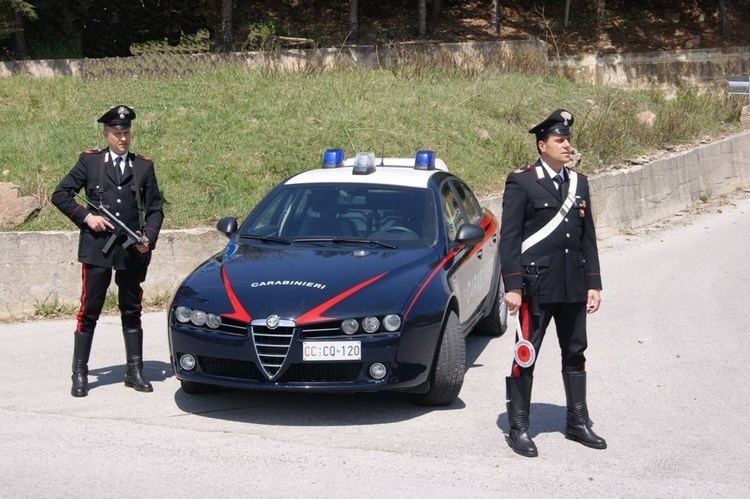Active 13 July 1814 Part of Ministry of Defence | Size 109,499 sworn members Headquarters Rome, Italy | |
 | ||
Country Kingdom of Sardinia
Kingdom of Italy
Italian Social Republic
Italy Type Gendarmerie (carabiniers) Role Military police and general expertise in permanent service of public security Founder Victor Emmanuel I of Sardinia Founded 13 July 1814, Turin, Italy Similar Italian Army, Italian Navy, Italian Armed Forces, Italian Air Force, Bersaglieri Profiles | ||
Millennium stage april 18 2016 banda dell arma dei carabinieri
The Carabinieri (formally Arma dei Carabinieri, "Arm of Carabineers" or previously Corpo dei Carabinieri, "Corps of Carabiniers"; [karabiˈnjɛːri]) is the national gendarmerie of Italy, policing both military and civilian populations. It originally was founded as the police force of the Kingdom of Sardinia. During the process of Italian unification, it was appointed the "First Force" of the new national military organization. Although the Carabinieri assisted in the suppression of opposition during the rule of Benito Mussolini, they were also responsible for his downfall and many units were disbanded by Nazi Germany, which resulted in large numbers of Carabinieri joining the Italian resistance movement. Since 2001, it has been one of the four Italian Armed Forces.
Contents
- Millennium stage april 18 2016 banda dell arma dei carabinieri
- Early history
- 1930s and 1940s
- Present day
- Organization
- The Mobile Unit Division
- ROS
- Special Tasks Departments
- War service
- Uniforms
- Decorations
- Weapons
- Ordinary weapons
- Special weapons
- Vehicles and equipment
- Cars
- Motorcycles
- Aircraft
- Tactical vehicles
- Ships
- Special Vehicles
- References

Early history

Inspired by the French Gendarmerie, the corps was created by King Victor Emmanuel I of Savoy with the aim of providing the Kingdom of Sardinia with a police corps. Previously, police duties were managed by the Dragoni di Sardegna corps, created in 1726 and composed of volunteers. After French soldiers had occupied Turin at the end of the 18th century and later abandoned it to the Kingdom of Piedmont, the corps of Royal Carabinieri was instituted under the Royal Patents of 13 July 1814.

The new force was divided into divisions on the scale of one division for each province. The divisions were further divided into companies and subdivided into lieutenancies, which commanded and coordinated the local police stations and were distributed throughout the national territory in direct contact with the public.
In 1868, the Corazzieri mounted division was formed – initially as an escort of honour for the sovereign, and since 1946 for the President of the Republic. The Italian unification saw the number of divisions increased, and on 24 January 1861 the Carabinieri were appointed the "First Force" of the new national military organization.
In May 1915 Italian troops marched to encompass South Tyrol, territory of their former allies the Austro-Hungarian empire, in the Fronte italiano campaign. The defenders had sufficient time to prepare strong fortifications there, and in the Carso theatre to the east, and the Italian regiments, under overall command of General Cadorna, found themselves repeatedly repulsed in harsh fighting. The role of the Carabinieri was to act as barrier troops, setting up machine gun posts to control the rear of the attacking regiments and prevent desertion.
1930s and 1940s
During the fascist regime of Benito Mussolini (1922–1943), the Carabinieri were one of the police forces entrusted with suppressing opposition in Italy. During the same period, while part of the Italian Africa Police (mainly in the late 1930s), they were involved in atrocities in colonial Italian East Africa during the Second Italo-Abyssinian War. During World War II they fought in their function as military police against the Allied forces, and against Yugoslav partisans as part of the Italian occupation force in Yugoslavia.
After Mussolini's fall on 25 July 1943, he was arrested by the Carabinieri as he left the king's private residence in Rome and subsequently imprisoned on Campo Imperatore by Carabinieri forces. After the armistice between Italy and the Allies on 3 September 1943 and the country's split into the fascist Italian Social Republic in the north and the Kingdom of Italy in the south, the Carabinieri split into two groups. In southern Italy the Carabinieri Command for Liberated Italy was founded in Bari, mobilizing new units for the Italian war of liberation. These units were attached to the Italian Liberation Corps and the six Italian Combat Groups of the Italian Co-Belligerent Army, fighting with the Allied forces. In northern Italy the fascist regime organized the Guardia Nazionale Repubblicana (composed of Carabinieri, former colonial policemen, Guardia di Finanza and customs police), to employ it as a military police and rapid-deployment anti-guerilla force. GNR was later joined (but not taken over) by the Black Brigades which should have represented a new militant incarnation of the Fascist party.
Due to the role the Carabinieri had played in the downfall of Mussolini, and since one of the few units which fought the German occupation of Rome were the Granatieri di Sardegna regiments and the II Carabinieri cadet battalion, the Germans did not view the Carabinieri as loyal to the fascist cause and ordered the disbanding of all Carabinieri units in Axis-controlled territory on 7 October 1943. As German forces subsequently began to arrest and deport members of the Carabinieri to Germany for forced labour, large numbers of Carabinieri joined the Italian resistance movement. After the war the Carabinieri counted at least 2,735 fallen and 6,500 wounded, out of approximately 14,000 who had joined the Resistance in northern and central Italy. In Yugoslavia the Carabinieri formed a battalion of the Italian partisan Garibaldi Division, which fought alongside the Yugoslav partisans against German and Croatian Ustaše Forces. The battalion lost over 80% of its members in combat and was awarded the Silver Medal of Military Valor to commemorate the fallen.
Present day
The Carabinieri increased in status and joined the Armed Forces on 31 March 2000. In their history they have made countless heroic actions, but they are today particularly proud of the memory of Vice Brigadiere Salvo D'Acquisto, who was executed by the Germans in Palidoro (near Rome) during World War II. D'Acquisto exchanged his life for the lives of citizens due to be executed in retaliation for the killing of a German soldier; instead, he claimed responsibility and was executed for the offence.
In recent years Carabinieri units have been dispatched on peacekeeping missions, including Kosovo, Afghanistan, and Iraq. In 2003 twelve Carabinieri were killed in a suicide bombing on their base in Nasiriyah, near Basra in southern Iraq, in the largest Italian military loss of life in a single action since the Second World War.
At the Sea Island Conference of the G8 in 2004, Carabinieri were given a mandate to establish a Center of Excellence for Stability Police Units to spearhead the development of training and doctrinal standards for civilian police units attached to international peacekeeping missions.
The State Forestry Corps was dissolved on 31 December 2016 and all personnel were militarized and absorbed by the Carabinieri.
Organization
The corps is headed by the Comando, consisting of the Comandante Generale (a General), the Vice-Comandante Generale ( a Lieutenant General) and the Chief of Staff, all located in Rome. The Chief of Staff directs, coordinates and supervises all activities of the force. It directly supervises the Directors of Administration, Health, Engineering, the motor pool and the Veterinary Commission. On the Deputy Chiefs of Staff depend the National Center for Recruitment and Selection, the Administration National Center and the Legislation Office.
The Carabinieri are organised on a territorial basis for law-enforcement missions. The territorial organization represents the core of the institution; it contains 80 percent of the force and is organized hierarchically in five inter-regional, 19 regional and 102 provincial commands. Outside the territorial organisation, the Specialist Mobile Unit Command Palidoro (based in Rome) controls the Mobile Unit Division, the Specialist Unit Division and the ROS.
The Mobile Unit Division
The Mobile Unit Division is located in Treviso and has two brigades tasked with mass manoeuvres during emergencies, defending the nation and participating in military operations abroad. It supports public order and territorial control in urban areas, and contributes to the operations of civil authorities in terms of public safety.
ROS
The ROS (Raggruppamento Operativo Speciale or Special Operational Group) is an elite unit founded in 1990 to deal with organised crime (Mafia and others), subversive activities, terrorism and more complex types of crime. An anti-crime section is found in every city and district public prosecutor's office.
Special Tasks Departments
Special Tasks Departments are outside the ordinary organisational framework and are used for special missions: Corazzieri (Cuirassiers) are an elite corps and honour guard of the President of the Italian Republic, located in the Quirinal Palace. They are distinguished by their uniforms and height (the minimum height for admission is 1.9 m or 6 ft 3 in). They have almost no other everyday duties, although they may be seen patrolling occasionally. Other departments are in service to constitutional bodies such as the Presidency of the Republic, the Senate, Parliament, the Judiciary, the Prime Minister and the National Council of Economy and Labour. Carabinieri also perform military police and security duties for the Ministry of Defence, military high commands, the offices of the military judiciary and allied military organisations in Italy and abroad. They also have personnel attached to the Department of Public Security in various departments, as well as anti-Mafia and anti-drug investigative task forces. Carabinieri officers are charged with surveillance and security at Italian embassies and consulates abroad, performing the same services entrusted to the United States Marine Corps in US diplomatic and consular offices.
Together with the Polizia di Stato and the Guardia di Finanza, the Carabinieri is also responsible for border control.
War service
The main battles in which the Carabinieri took part before World War I are:
For its contributions during the First World War, the Corps was awarded its first Gold Medal of Military Valor
In World War II, Carabinieri distinguished themselves in the following battles:
From 1943 to 1945, the Carabinieri were accountable to the Control Commission of the Allied Military Government (AMGOT). Their reorganization and reform was organized by Colonel Arthur Young, a British police officer seconded as Director of Public Safety and Director of Security.
Uniforms
The Carabinieri were issued a distinctive uniform in dark blue with silver braid around the collar and cuffs, edges trimmed in scarlet and epaulettes in silver. The mounted division had white fringes, and the infantry had light blue. Their headgear was a distinctive bicorne, popularly called the lucerna. They still use a version of the historic uniform today for ceremonies.
The full set of different Carabinieri uniforms today is presented here (in Italian).
Carabinieri MP Units wear a dark navy blue beret.
Decorations
The State Color of the Carabinieri bears the following decorations:
Weapons
In response to the many and diverse needs of the Carabinieri, the service provides for the use of various types of weapons that are divided into "ordinary" and "special" weapons and supplied to all staff as follows:
Ordinary weapons
Special weapons
Used only by certain departments and under certain circumstances:
Vehicles and equipment
Until very recently the Italian police (including the Carabinieri) operated only Italian-made vehicles, but that changed with the introduction of Land Rover Defenders and Subarus into service. Normal Carabinieri patrol vehicles are dark blue with a white roof, with a red stripe along the side. Carabinieri license plates begin with "CC" or previously with "EI" (formerly Esercito Italiano, Italian Army), and a Carabinieri car is traditionally called a Gazzella (gazelle). Small or medium-sized cars are used for ordinary patrol work, with larger and more powerful vehicles being used for emergency response, highway patrol, and special services. The vehicles of the Carabinieri military police and mobile units are painted in NATO camouflage scheme as done with the other Italian Armed Forces vehicles.
